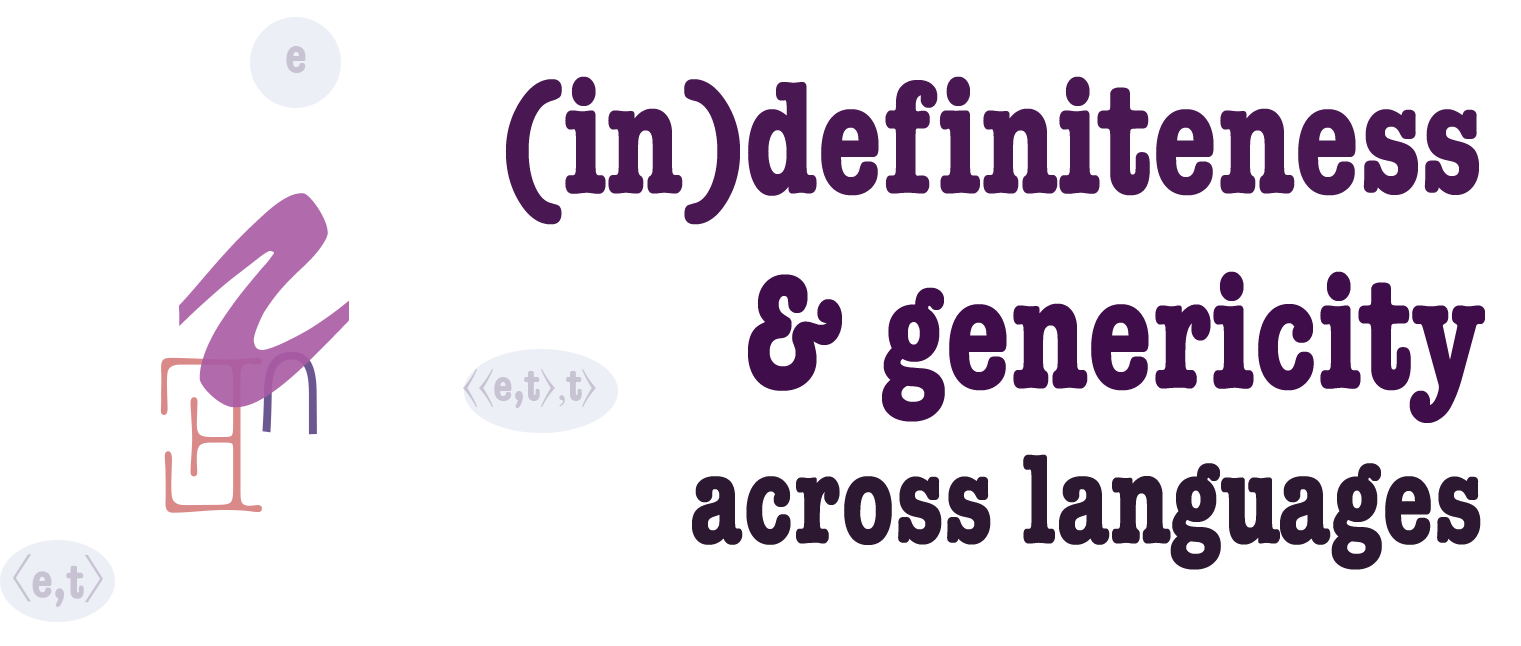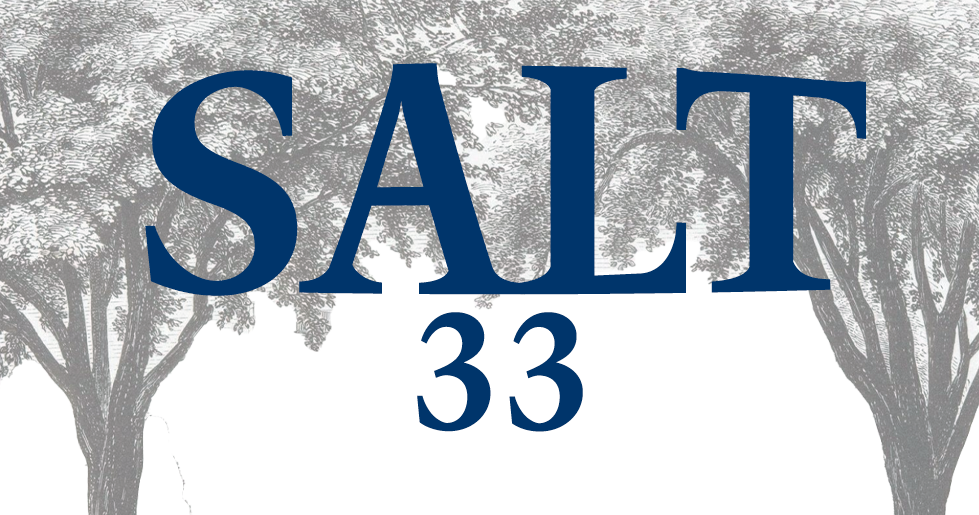
| general introduction/opening session chair: Gennaro Chierchia | ||
| 2.30–3.10 | Highlights from the Hitchhiker's Guide to Bare Nominals [slides] |
Veneeta Dayal |
| 3.10–3.30 | Bardi: Deducing (in)definiteness from archival materials Five issues for interpreting the Hitchhiker's questionnaire [handout | slides] |
Claire Bowern |
| session 1 chair: Manfred Krifka | ||
| 3.30–3.50 | Split-scope definites in Russian
In this talk, I focus on split-scope definites in Russian (the rabbit in the hat
in a context with a plurality of rabbits and hats but only one rabbit-hat pair), a construction that has not so
far been studied. It presents fresh evidence for the importance of uniqueness in the semantics of Russian bare singulars.
As background, Soloveva, Polinsky and Dayal (to appear) find that: (i) Russian bare singulars are kind terms and are
acceptable in generic statements, (ii) Russian bare singulars display the uniqueness and anaphoric potential typical of
definites, (iii) Russian bare singulars can introduce new entities and are in that respect like indefinites, but they
cannot take existential wide scope over other operators nor can they have partitive specific readings and are
unlike indefinites in that respect. These conclusions are based on the (In)definiteness Questionnaire of Dayal (to appear).
While the inability of Russian bare singulars to take wide scope has been confirmed by Geist (2010),
the reliance on uniqueness claimed in Dayal (2004) has been questioned by several authors,
most recently in an experimental study by Simik and Demian (2020). In this talk I focus on expanding
the empirical landscape in which we observe that Russian bare singulars have a uniqueness requirement by
considering this new type of construction.
[slides] |
Anita Soloveva |
| 3.50–4.10 | Is the Cuzco Quechua plural marker kuna optional? Previous work on Cuzco Quechua has claimed that the suffix -kuna is an optional plural
marker (Faller 2007). We present evidence against this. By looking at inanimate and animate nouns, in subject and in object
position we find that nouns marked with -kuna denote more than a simple plurality of individuals. They may refer to a group
with different types of objects in it, or multiple groups of different types, or a combination of the two.
We suggest that -kuna represents a sorting mechanism for items within a group. We base this on the interpretive possibilities
available to inanimate nouns with -kuna, where the picture is relatively clear. We present the facts for animate nouns,
showing that the claim for optionality does not hold (it is needed at times for plural reference).
How the sorting mechanism applies in the animate domain is work in progress. [slides] |
Liliana Sánchez & Janett Vengoa |
| 4.10–4.30 | The mass/count distinction in classifier languages: insights from ERPs on processing
Korean number morphologyWhile it has been argued that generalized classifier languages such as Korean and Chinese lack
the syntactic count/mass distinction in their grammars (Chierchia, 1998, Krifka, 1995), others
have claimed that the syntactic count/mass distinction is needed to account for the distribution
count versus mass classifiers in Chinese (Cheng & Sybesma, 1998, 1999).
In the present study we investigated the question of whether Korean is also constrained by the
count/mass distinction in its classifier system (Experiment 1). In Experiment2, we investigated
the optional marking of plurality through the morpheme TUL, which we expect to be possible
with count but not mass nouns if there is a syntactic count/mass distinction in Korean.
In Experiment 1, the collocation of mismatching classifiers (count noun + classifier for
substances; mass noun + classifier for objects) elicited both N400 and P600, which implies that
classifier mismatches are syntactically processed and not just semantically.
In Experiment 2, we examined ERPs responses to TUL-attached to nouns denoting objects and
substances. If TUL-marking is constrained by the syntactic count/mass distinction, we expect
the former to be well-formed, and the latter to be unacceptable. In our results, however, we
found that adding plural marker TUL elicited an N400 regardless of whether it was attached to
object-denoting or substance-denoting nouns. This implies that speakers of Korean take the
combination of noun and the plural marker TUL to be marked, preferring to use a bare noun in
the relevant contexts.
However, we found a significant interaction between classifier type and the plural marker TUL.
Even though the difference was not significant, in the count category, the combination of noun
and the plural marker TUL elicited P600 to a higher degree compared to bare nouns, while in
the mass category, the bare form elicited P600 more than the combination of noun and the
plural marker TUL. These results suggest that the plural marker TUL might not be processed
syntactically by native Koreans.
We take these results to imply that the syntactic count/mass distinction exists in Korean, unlike
Kanero et al (2015) who did not find evidence for it in the syntactic processing of classifiers in
Japanese. The distinction manifests itself in the classifier system, which is a robust part of
Korean grammar. As for why -TUL-marking is not fully constrained by the count/mass
distinction, our answer is that it is not a fully grammaticized marker of plurality. We suspect
that as more speakers use TUL as a grammaticized marker of plurality, its use may increasingly
be constrained by the count/mass distinction. |
Sea-hee Choi & James Yoon |
| 4.30–4.45 | Break | |
| poster session celebrating 25 years of ‘Reference to Kinds across Languages’ & 40 years of inspiring ideas from its author | ||
| 4.45–5.50 |
posters Comfort Ahenkorah, Ushasi Banerjee, Daria Bikina, Indira Das, Janek Guerrini, Jeremy Johns, Fereshteh Modarresi & Manfred Krifka, Augustina Owusu, Yagmur Sag, Ankana Saha, Sadhwi Srinivas. full list |
|
| 5.50–6 | short break | |
| session 2 chair: Florian Schwarz | ||
| 6.00–6.20 | Definiteness and Genericity in Cabo Verdean Creole and Mandinka Creole languages typically emerge in multilingual settings among language users endowed with distinct first languages. As a result of the intense and oftentimes long-term contact between users, the languages in contact leave long-lasting imprints on the emerging Creole language. The traces of the founding populations (the Founder Principle, Mufwene, 1996) can be observed at the lexical, phonological, morphosyntactic and semantic levels of the Creole language, next to internal developments and genuine innovations that make the Creole language a distinct linguistic system that stands independently from its source languages.
The objective of this presentation is to compare Cabo Verdean Creole both to its Portuguese lexifier and to one of its main substrates, Mandinka (Quint, 2006), to evaluate whether traces of these source languages are observable in Cabo Verdean, specifically with respect to its use of demonstrative and definite determiners.
We show that with respect to number morphology on demonstrative phrases, the behavior of the Cabo Verdean demonstrative can align either with Portuguese or with Mandinka,
leading to the variation documented in Baptista and Dayal (to appear). These results support the Founder Principle.
In contrast, when one examines reference to kinds/genericity, the behavior of Cabo Verdean is distinct from both Portuguese and Mandinka
which require definiteness marking on both singular and plural nouns. Cabo Verdean only uses bare nouns. This does not support the Founder Principle,
showing instead that Cabo Verdean has undergone internal development in that aspect of its grammar.
[slides] |
Marlyse Baptista & Ousmane Cisse |
| 6.20–6.40 | Expressing (in)definiteness across Austronesian
Beginning in the Philippines, I offer a critical view of recent analyses that discount the referential properties of Tagalog case markers and argue that the referential properties of case markers make a key contribution to the interpretation of arguments in Tagalog and more widely in the Philippine zone. I then examine languages south of the Philippines that have lost case-marking determiners and propose a typology of strategies that compensate for this loss. I show that syntactically conservative languages maintain the general mapping of definite undergoers to the nominative/absolutive argument with and without reinforcement by semantically bleached determiners and relative markers. I also discuss a rarer pattern by which a third singular genitive becomes a general marker of possession and then a marker of identifiability via “associative anaphora”. Finally, I turn eastwards to discuss head-marking strategies, as found in Muna, where a historically distributive/pluractional verbal morpheme has come to signal the presence of an indefinite object. The typological goal, to which this is but an initial approach, is to link particular types of historical grammaticalizations to particular types of readings in modern languages.
|
Daniel Kaufman |
| 6.40–7.00 | Extraction evidence on the syntax of Xhosa nominal expressions
Because Xhosa lacks overt marking(s) of (in-)definiteness comparable to English a and the,
the size and category of nominal expressions is unclear: are they DPs, NPs, or something in between? I present syntactic tests
proposed in Bošković (2005, 2011) and apply them to Xhosa. I show that Xhosa does not pattern with DP-less Serbo-Croatian in
having free extraction from nominals. Object marking makes possible extraction from Xhosa nominals, but only of prenominal
demonstratives. I argue that (i) Xhosa nominals are phasal DPs and (ii) agreement can “unlock” a phase for extraction from
its edge – not for extraction from its interior (Van Urk & Richards 2015). [slides] |
Vicki Carstens |
| 7.30 – 8.30 | Dinner | 2nd floor Luce Hall —free but please register here |
| Comfort Ahenkorah | Pluralization strategies in Akan | |
| Ushasi Banerjee | Khasi in the typology of classifier languages | |
| Daria Bikina | (In)definiteness in Russian bare nouns revisited: an experimental study | |
| Indira Das | Number interpretation in bare noun definites in Odia | |
| Janek Guerrini | On pervasive kind predication in Italian | |
| Jeremy Johns | The Semantics of the O’odham determiner g | |
| Fereshteh Modarresi & Manfred Krifka | Generic sentences in a differential object marking language: the case of Persian | |
| Augustina Owusu | Definitely a question: definiteness markers in Akan ex-situ questions | |
| Yağmur Sağ | Cardinality and (in)definiteness | |
| Ankana Saha | Reference to kinds: the perspective from Bangla | |
| Sadhwi Srinivas | A unified syntax-semantics interface for Kannada bare existential singulars | |

